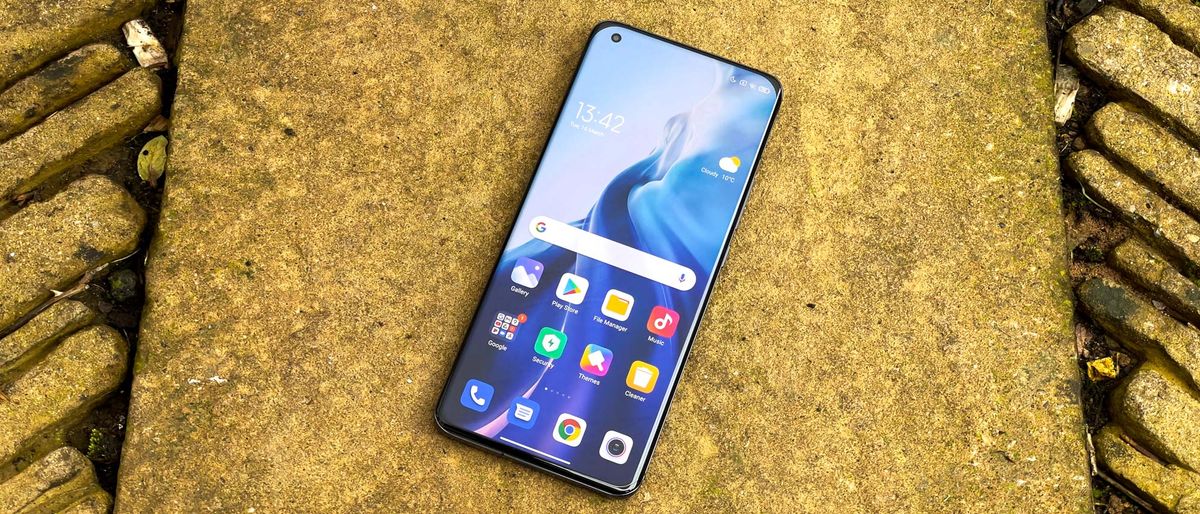Tom's Guide Verdict
The best deal in Android flagships right now, the Xiaomi Mi 11 offers an amazing platform for streaming video and running demanding apps and games, tied together with an enjoyable software experience. But you lose out on camera power — assuming you can get it in the first place.
Pros
- +
Good macro photography
- +
Above-average specs for price
- +
Awesome curved QHD display with variable refresh rate
- +
Powerful chipset
Cons
- -
Not available in U.S.
- -
Underwhelming general camera performance
Why you can trust Tom's Guide
Starting price: £749
Display: 6.81-inch QHD AMOLED (3200 x 1440)
Refresh rate: 30 - 120Hz
Rear cameras: 108MP main (f1.8), 13MP ultrawide (f2.4), 5MP telemacro (f2.4)
Front camera: 20MP (f2.2)
Chipset: Snapdragon 888
RAM: 8GB
Storage: 128GB/256GB
microSD: Not available
Operating system: Android 11 with MUI 12
Battery: 4,600 mAh
Charging: 55W wired, 50W wireless, 10W reverse wireless
Colors: Midnight Gray (pictured), White, Horizon Blue
Size: 6.5 x 2.9 x 0.3 inches (164.3 x 74.6 x 8.1mm)
Weight: 6.9 ounces (196g)
IP rating: n/a
With a price lower than the Samsung Galaxy S21 and the offer of superior specs in several areas, the Mi 11 will delight anyone who fancies picking one up with just how much it packs into the phone.
In fact, the Mi 11 is one of my favorite phones I've tested.
Throughout this Xiaomi Mi 11 review, you'll see that this phone isn’t lacking when it comes to hardware. Its display and performance specs together make this a great phone for gaming, streaming or using CPU-intensive apps.
Its user experience is also enjoyable, the software adding smart enhancements to the basic Android experience and its battery offering an effective mix of long life and speedy charging. Plus it's a pretty handsome piece of glass and circuitry to boot.
But while U.K. shoppers can find the Xiaomi Mi 11, U.S users won’t be able to. And when it comes to cameras, the Mi 11 starts to stumble a bit.
Xiaomi Mi 11 review: Price and availability
Xiaomi brought the Mi 11 to the U.K. on March 16, where it retails for either £749 for the 128GB storage version, or £799 for 256GB.
As a comparison, a Galaxy S21 with 128GB storage sells for £769, while a 128GB iPhone 12 goes for £849. It's not as big a price difference as we were hoping before the announcement, but the Mi 11, particularly the 256GB version, is quite the bargain compared to its rivals.
There's no U.S. availability for Xiaomi, with the company currently in dispute with the U.S. government. (Not that Xiaomi phones were readily available in the U.S. before that.) You'll probably be able to find it available for import if you've got your mind set on a Mi 11, but given the additional cost and potential trouble with 4G/5G band compatibility, you're probably better off buying a phone that's already sold in your country. Our guide to the best Android phones is a good place to start if you need alternative ideas.
Xiaomi Mi 11 review: Design
From the front, the Xiaomi Mi 11 resembles many other Android flagships, but it's still a looker. It's set apart by its quad-curve display, which gives the phone a stylish profile that catches the light attractively.
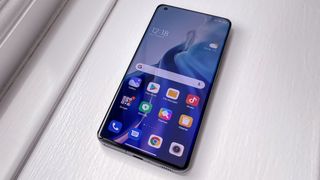
I can't make up my mind on the look of the Mi 11’s back though. The camera bump in the top-left corner throws me off, since its three-part structure looks muddled, even if the rounded square shape and silver ring around the main lens look the business from a distance.
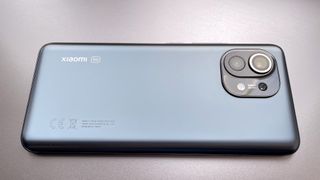
It doesn't help that the rest of the back is plain aside from logos and regulatory text toward the bottom, which only makes it easier for your eye to settle on the cameras.
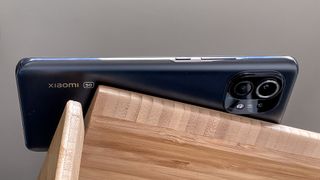
The Xiaomi Mi 11 screen's made of Gorilla Glass Victus, the same glass found on the Galaxy S21, so you shouldn't have to worry too much about small scratches appearing by accident. You'll need to be more careful about exposing the Mi 11 to water and dust though; while Xiaomi says the phone is water-resistant, it doesn't have an official IP rating.
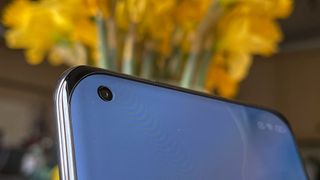
U.K. shoppers have a choice of three basic colors: a plain white, Midnight Gray and Horizon Blue. The gray of my review unit looks classy with its satin-style finish (aside from all the fingerprints it picks up), although I like how the blue and white add a little more visual interest to the phone.

Xiaomi Mi 11 review: Display
With a 6.8 inch-AMOLED panel, the Xiaomi Mi 11 is on the larger side of this year's Android flagship phones. However a QHD resolution, 1,500-nit maximum brightness and a variable 120Hz refresh rate mean this isn't just another big screen phone.
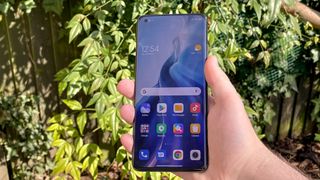
Those impressive features don't cause battery life to suffer excessively, either. The Mi 11 offers both a variable resolution and variable refresh rate, so under certain conditions, the phone will scale down to FHD, while opting for a 90Hz, 60Hz or 30Hz refresh speed to save you power. The approach isn't as versatile as the LTPO display on the identically-sized Galaxy S21 Ultra, which can vary anywhere between 10Hz and 120Hz. But Xiaomi’s approach with the Mi 10 is still effective.
I loved watching video on the Mi 11. Poring over the trailer for the upcoming Teenage Mutant Ninja Turtles: Shredder's Revenge, the bright colors, be it the green of the four testudine protagonists or the purple of their enemies' jumpsuits, were positively glowing. Ironically, the high-resolution display let me really appreciate the grainy, retro animation style that the game's cinematic uses to call back to the original cartoon.
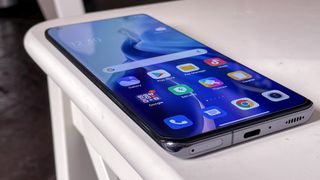
Technically the Mi 11 display curves around the side of the phone on all four edges, but this is only noticeable on the left and right, and even then the curved portion is mostly bezel. The top and bottom curves are very subtle, with a particularly obvious bottom bezel. However the phone does feel nice to hold horizontally as a result.
Xiaomi's added a "hardware-level mistouch sensor" to avoid you accidentally swiping the screen just by holding the curved edges. I didn't notice the phone being particularly sensitive to accidental touches, so this system seems to do its job. If you want, you can alter the settings so the dead zone around the edges is larger or smaller if the automated system isn't to your liking.
Xiaomi Mi 11 review: Audio
Evidently quite proud of its Harman/Kardon- tuned stereo speakers, Xiaomi emblazons the speaker company's name on the top edge of the Mi 11.
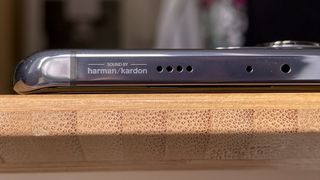
Listening to British rap artist Dave's "Location", I was impressed with the phone's depiction of his vocals and the mid-range instrumentation behind him. But as is often the case with phone speakers, the bass frequencies were lacking power.
Still, listening to the same song on an iPhone 12 Pro, it became clear that percussion is a lot more prominent on the Mi 11, which if anything made the listening experience a bit worse. However, I also noticed an impressive sense of width from the Xiaomi's speakers too. Whether or not the speakers deserve the Harman/Kardon badge for quality, they deserve them for the mini soundstage effect they conjure.
Xiaomi Mi 11 review: Cameras
Although not the most powerful or diverse camera array available, the Xiaomi Mi 11 covers the basics. The back three cameras consist of a 108MP main camera, a 13MP ultrawide camera and a 5MP macro camera, plus a flash. On the front, you have a single 20MP selfie cam.
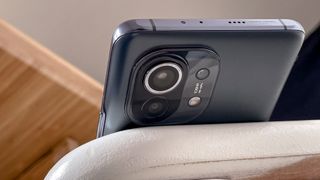
While you can set the main camera to take 108MP photos via the Pro mode in the Mi 11’s camera app, the phone takes 27MP photos by default. The Mi 11 manages this by combining sensor data from four pixels into one virtual pixel, a process called pixel binning. This saves you space in your phone's storage, plus it's ideal for low-light shots, at least in theory.
That doesn't seem to have helped the Mi 11 capture this view over an inner London park. It's much darker than the iPhone 12 Pro's image I'm using for comparison, which makes it hard to notice any additional detail the 27MP shot gets over the 12MP iPhone photo.
Switching to 108MP mode on the Xiaomi Mi 11 goes some way to addressing this problem. The straight lines and bright colors of the playground apparatus stand out much more, and makes it a far better rival for the iPhone shot. That's fine, except 108MP images can take up to nine times as much storage space as 12MP shots. That will fill up any phone's onboard storage pretty quick.

The ultrawide camera on the Mi 11 has a magnification of 0.6x — common for Android phones but less extreme than the 0.5x camera on the iPhone 12 Pro, hence the different look of these two images of Archway. Either way, this round belongs to the iPhone thanks to its much richer colors.
The only thing missing from a typical flagship camera set-up on the Mi 11 is a telephoto sensor, but these tend to appear on more expensive models of flagships, such as the expected Xiaomi Mi 11 Pro. What you get instead with the Mi 11 is a "telemacro" camera. A lot of cheaper Android phones include macro cameras, but the Mi 11's version offers variable magnification to better achieve good close-up shots.
The result is the best macro shot I've taken with a dedicated macro lens on a smartphone. I tried taking the same shot of this daffodil with the main camera too, and while I was able to get a better focus on the stigma in the center, I couldn't focus on the petals at the same time, and the colors are far less vivid. It's convincing enough proof of the camera's inclusion is worth your time, rather than it being a cynical attempt by the phone maker to bump up the lens count.

It's still very hard to take these macro photos without any stabilization. The one you see here was from a selection of 17 attempts. Normally, it takes me five at most to find a shot I'm happy with.
I have to hand it to Xiaomi when it comes to the selfie cam. Normally I enjoy the more vivid colors you see in an iPhone 12 Pro selfie, but here I just look sunburnt. The Xiaomi has supplied a much more natural-looking selfie, plus does a slightly better job of cutting my head out from the trees in the background. The tradeoff is a much smoother image, which looks more artificial despite the colors better reflecting those I saw in the viewfinder.
Xiaomi Mi 11 review: Performance
Under the hood, the Xiaomi Mi 11 features a Qualcomm Snapdragon 888. While you get the latest chipset Qualcomm has to offer, you only have 8GB RAM, which pales in comparison to the 12GB you can now find on top performing Androids like the Galaxy S21 Ultra or Galaxy Note 20 Ultra.
It's still enough for the Xiaomi to really impress. On the Geekbench 5 general benchmark, the Mi 11 scored 1,112 on the single core section and 3,379 on the multi-core section. The basic Galaxy S21 only manages 1,048 and 3,302 respectively.
The Galaxy S21 Plus, which uses the same chip and RAM capacity, beat the Mi 11's single core score with 1,116, but the Mi 11 edged out the S21 Plus’ multicore score of 3,300. The S21 Ultra easily beats the Mi 11 on both tests, but has an easy advantage thanks to 12GB of RAM.
In 3D Mark's Wild Life graphics test, the Mi 11 achieved a score of 5,676, which averages to 34 frames per second. That tops the Galaxy S21's 5,504 point/33 FPS result while finishing in line with the Galaxy S21 Plus (5,650/34 FPS).
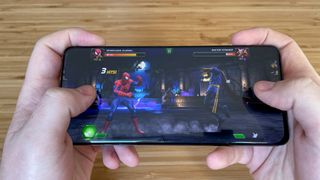
Trying out Marvel Contest of Champions proved that these scores are reflected by real-world performance. Watching Spider-Man beat up rival superheroes looked great and displayed smoothly on the Xiaomi Mi 11. The Mi 11's 480Hz touch sampling rate allows the display to react faster to taps than the average phone's.
There's also a vapor cooling chamber built into the Mi 11, which is likely why I didn't notice the phone heat up even after trying out all the games I downloaded, or during the benchmark tests. Even charging up the phone didn't noticeably increase the temperature of the casing.
Xiaomi Mi 11 review: 5G
The badge on the back of the Mi 11 tells you it's a 5G-ready phone. However making sure you'll actually be able to use it on a faster network is a little more complicated.
5G networks work on one or more signal bands, which some phones can pick up and others can't. This is why if you're determined to bring a Mi 11 over to the U.S., it's crucial you check which bands your mobile carrier offers and which the Mi 11 will work with.
U.K. customers shouldn't have to worry though. There's much greater unity between the 5G carriers over here, and all of them should offer 5G support with the Mi 11 according to Xiaomi's specs.
Xiaomi Mi 11 review: Battery life and charging
The 4,500 mAh battery in the Xiaomi Mi 11 is smaller than average for a phone of this size. The Samsung Galaxy S21 Ultra has a 6.8-inch screen like the Mi 11, but gets a 5,000 mAh cell.

Nonetheless, the Mi 11's battery does a good job at keeping the phone powered up. After watching an hour of YouTube in full screen mode (the main battery-intensive activity I use my phones for), the Mi 11 lost 8% of its total charge. That equates to a full day of binge-watching the remakes of Hamilton songs in Animal Crossing: New Horizons, which means the Mi 11 will probably handle a day of actual work capably without needing an emergency trip to a charging plug.
The Mi 11 also gets points by not only including a charger in the box, but by offering you a 55W block to match the phone's maximum charging speed.
There are a few faster charging standards out there, for example, the 65W one used by the OnePlus 8T. But filling your phone to 45% in 15 minutes, 80% in 30 and 100% in 48 minutes as you can with the Xiaomi Mi 11 is still respectably fast. It certainly beats the 25W charging offered by the Galaxy S21, which doesn't come with an included charger in the box.
The 50W wireless charging on the Mi 11 means you should achieve almost identical speeds to those above without cables. However you'll need one of Xiaomi's own charging pads to hit that speed and since we don't have one we couldn't check the speed for ourselves.
Finally, the Mi 11 offers reverse wireless charging up to 10W to give a friend's phone a boost of power or to keep your wearables and wireless earbuds topped up.
Xiaomi Mi 11 review: Software
The typical Android 11 features come wrapped in Xiaomi's MIUI 12 on the Mi 11. It balances the super clean look of stock Android seen on phones like the Google Pixel 5 with the more modified feature set of something like the Galaxy S21's One UI, which is an overall positive.
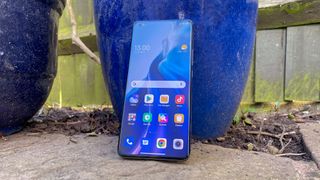
Among the unique enhancements in MIUI 12 are floating windows, which let you open a fully functional resizable window of one app over another, either from a notification or via the recent apps screen. All modern Android phones can open two apps in split screen, but this gives you more freedom to look at the areas of the apps that you want, quickly taking notes from a browser window or even copy and pasting between them just as one example.
Other handy but less notable features include an always-on display, an optional app drawer, and security offerings like blurring app previews and removing location data from shared photos. MIUI also offers an iOS-style option to divide the notification shade and quick settings menu into two, accessed separately by swiping down from either the left or right side of the top edge of the screen.
The phone ships with a fair number of bundled-in Xiaomi and third-party apps. But the Mi 11 is thoughtful enough to pack these away into a handful of folders for a less messy home screen, assuming you don't want to just delete them all.
Xiaomi Mi 11 review: Verdict
Our Xiaomi Mi 11 review finds an impressive phone, with very few omissions. It would have been nice to have a telephoto camera on the back instead of the telemacro lens, and a bigger battery would have been welcome, too. But even without those features, this phone still comes with premium capabilities comparable to more expensive phones.
We have little hesitation in recommending this to an Android fan looking for an alternative to Samsung, particularly if you prioritize streaming videos or playing games over capturing photos. However photography addicts, and especially U.S. shoppers, should look elsewhere for the time being.

Richard is based in London, covering news, reviews and how-tos for phones, tablets, gaming, and whatever else people need advice on. Following on from his MA in Magazine Journalism at the University of Sheffield, he's also written for WIRED U.K., The Register and Creative Bloq. When not at work, he's likely thinking about how to brew the perfect cup of specialty coffee.
